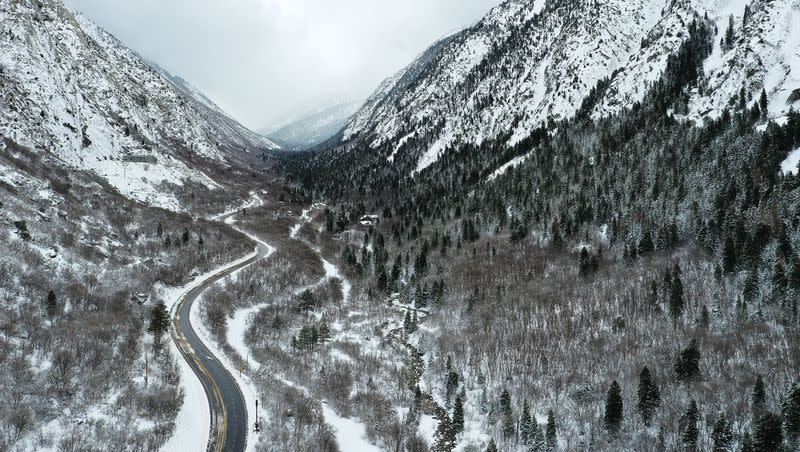Opinion: A former mayor’s solution — Put a train up Little Cottonwood Canyon

The Utah Department of Transportation made a bad decision for a gondola as the long-term transportation solution in the Little Cottonwood Canyon Environmental Impact Statement, or EIS. The decision is comparable to other narrowly focused failed “solutions” that threaten the character of the Central Wasatch Mountains, including Interconnect and SkiLink.
Prioritizing the interests of private ski resorts, at enormous public cost, is bad public policy.
Had UDOT provided an honest assessment of previous work on this issue, current realities, true lifecycle costs and environmental impacts, the EIS would have seriously considered a mountain train alternative.
Rail systems in the European Alps and worldwide show how effectively trains can both serve the public and protect sensitive and scenic mountain environments. Rail has many advantages over gondolas and buses. It has a smaller geographic footprint and longer lifespan, reduces air pollution, ties easily into existing regional transit systems, and offers a more enjoyable user experience.
Related
Yet UDOT’s EIS Record of Decision ignored this option on the premise that it is too expensive. But evidence and experience show that over a period of decades, rail costs less than other modes, is safer, and is the most sensitive to the environment.
During preparation of the Environmental Impact Statement, a detailed proposal by rail experts was submitted to UDOT for an electric, battery-operated train at half the cost of UDOT’s estimate. Rail provides a range of advantages as a viable alternative that could work in the Wasatch Mountains:
Rail cars can easily be added together, enabling one train and driver to carry several hundred people at a time.
Trains last far longer than other modes. The life cycle of a bus is between eight and 10 years, and it has substantial operational and maintenance costs. Trains last many decades and have lower operational costs with fewer moving parts to repair or replace.
A rail alignment already exists in Little Cottonwood Canyon; it was used for decades a century ago for mining and recreation.
No new roadway would be necessary, and the unsightly, expensive avalanche sheds would not be necessary.
People like train travel. Rail offers a far more enjoyable user experience than a packed bus or gondola. And it could stop along the route, serving a diversity of users.
A train could tie to existing rail lines in the Salt Lake Valley, making the canyon far more accessible without a car, reducing congestion and air pollution. And adding rail to the southeast quadrant of the Salt Lake Valley would add transit accessibility for a large portion of Salt Lake’s traveling public. Service would run year-round for all trip purposes.
The need for massive parking structures at the mouths of Big and Little Cottonwood canyons (part of the UDOT decision) could be significantly reduced, and impacts to communities at the canyon entrances also would be diminished. For example, when the University of Utah rail line was built from downtown, traffic and parking needs on campus were reduced by 40%.
Skeptics and detractors of a rail solution argue that better bus service will solve or significantly reduce the transportation woes of Little Cottonwood Canyon. One positive recommendation in the environmental report is to start making significant bus improvements immediately. But for a variety of reasons, transit experts are skeptical that buses will address the canyon’s transportation needs. These include the low seat capacity of buses compared to the high number of visitors traveling in the canyon, high long-term costs and road limitations that were so apparent during the 2022-23 winter.
Related
The shuttle bus system at Zion National Park, often cited as a model solution, is a false parallel. The Central Wasatch has higher visitation and extreme winter mountain conditions that alter viable transportation solutions.
Users of the Wasatch mountains deserve an intelligent, future-focused, region-wide evaluation of transportation solutions reflecting the needs of impacted communities, the natural environment and the public interest.
And any transportation solution for these mountains — given the exploding growth in visitation and use — should include congressionally mandated land and resource protections, as reflected in the consensus Mountain Accord agreement and in multiple, vetted drafts of the Central Wasatch National Conservation and Recreation Area proposal.
The traffic problems UDOT attempted to address are extreme: congestion is increasingly unacceptable in both Little Cottonwood and Big Cottonwood canyons. More and more people are flocking to our world-class resorts and beloved mountains, not only in winter but year-round.
But because UDOT failed to provide an adequate assessment of the rail option and so narrowly restricted their impacts assessment, the pros and cons of a train system were never meaningfully considered. Following the UDOT path, Utah is losing an opportunity to improve our transportation system and environment, move people more efficiently, and create a mountain travel experience the envy of North America.
A Wasatch mountains transportation evaluation should answer important rail questions, including a preferred alignment, riparian impacts and mitigation alternatives, tying to the existing transit system, and the relationship to Big Cottonwood Canyon, where transportation challenges are equally pressing.
Now that UDOT’s flawed decision is final, stakeholders and communities who use and treasure this beloved resource should look more closely at trains as a transportation system that can work for everyone, well into the future.
Ralph Becker is former Salt Lake City mayor (2008-2015), executive director of the Central Wasatch Commission (2018-2022), Utah House of Representatives member (1997-2008) and consultant at Bear West (1985-2007).

